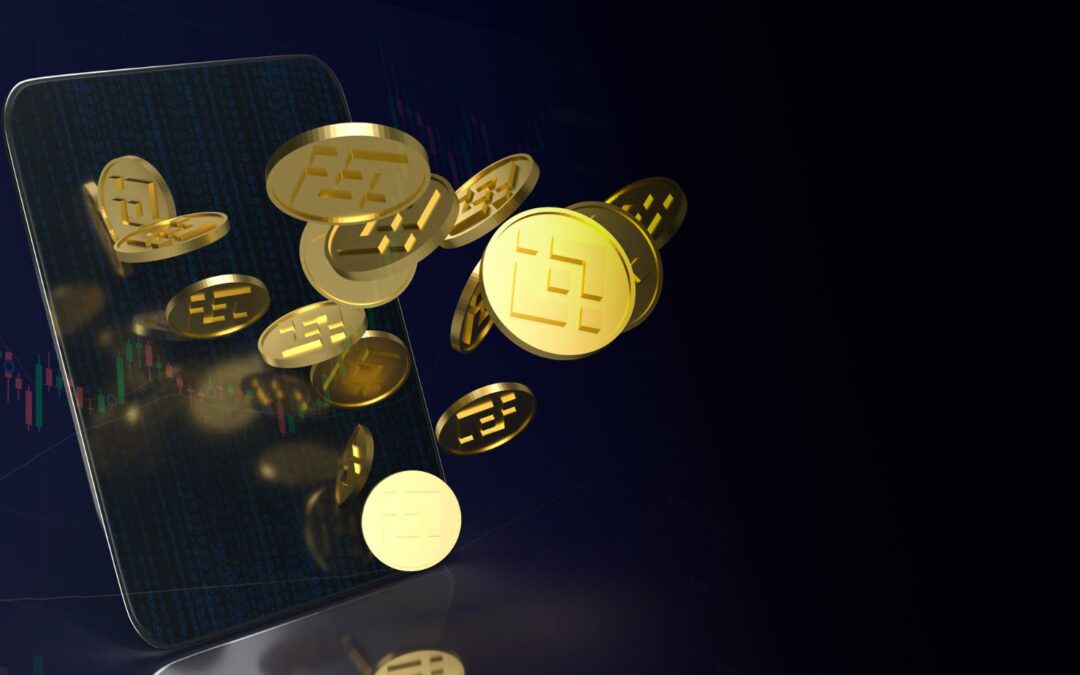In 2024, some of the top altcoins to watch include Ethereum (ETH), Binance Coin (BNB), Solana (SOL), and Cardano (ADA). These altcoins have shown strong potential for growth and innovation within the cryptocurrency market. Keep a close eye on their developments and market trends throughout the year.
10 Altcoins to Watch in 2024
As the crypto world continues to expand and carve its niche in the cointrade global financial ecosystem, certain altcoins have emerged as noteworthy contenders, each with its unique value proposition and technological advancement. Let’s shine a spotlight on each of these top 10 altcoins to understand why they stand out and why they’re worth keeping an eye on in 2024.
Ethereum (ETH)
Ethereum, often hailed as the pioneer of smart contract functionality, has continued to be a frontrunner in the crypto space. Its significance lies not only in its native cryptocurrency, Ether but also in its underlying blockchain network, which supports decentralized applications (dApps) and facilitates the creation of new tokens through smart contracts. With the much-anticipated transition to Ethereum 2.0 underway, featuring scalability improvements and a shift from proof-of-work to proof-of-stake consensus mechanism, Ethereum remains a pivotal player in shaping the future of decentralized finance (DeFi) and the broader blockchain landscape.
Binance Coin (BNB)
Boasting a strong presence as the native coin of Binance, one of the world’s largest cryptocurrency exchanges, Binance Coin has demonstrated resilience and versatility. It serves a multitude of purposes within the Binance ecosystem, such as facilitating trading fee discounts, participating in token sales on the Binance Launchpad, powering decentralized exchange (DEX) transactions on Binance DEX, and functioning as a utility token for various services offered by Binance. Moreover, constant developments and initiatives led by Binance continue to fortify Binance Coin’s position as a prominent utility token within the crypto sphere.
XRP
XRP, developed by Ripple Labs, has been designed with a focus on enabling efficient cross-border payments and fostering interoperability among diverse financial systems. Its swift settlement capabilities and low transaction costs make it an enticing option for institutions seeking streamlined cross-border remittance solutions. Despite facing regulatory challenges in certain jurisdictions due to its distinct operating model, XRP’s potential for revolutionizing traditional banking infrastructure and global payments warrants close observation in light of evolving regulatory landscapes around digital assets.
Cardano (ADA)
Cardano distinguishes itself through a meticulous research-driven approach toward building a robust blockchain platform that prioritizes scalability, sustainability, and interoperability. Founded on scientific principles and academic rigor, Cardano strives to offer a secure and scalable infrastructure for deploying dApps and executing complex smart contracts. The ongoing rollout of key protocol upgrades, such as the Alonzo hard fork enabling smart contract functionality, underscores Cardano’s commitment to carving out its presence as a formidable player in the realm of blockchain innovation.
Dogecoin (DOGE)
Despite its origins as a lighthearted meme-inspired project, Dogecoin has gained remarkable traction within the crypto community and captivated widespread attention due to its vibrant community backing and enduring cultural appeal. While initially intended as a playful digital currency, Dogecoin has undertaken strides towards enhancing its utility by integrating features that foster microtransactions and tip-based economy. The recent adoption by notable entities and celebrities further amplifies Dogecoin’s resonance as an intriguing experiment at the intersection of technology and pop culture.
Solana (SOL)
Solana has swiftly garnered recognition for its high-performance blockchain architecture that presents a compelling vision for scalability without compromising decentralization or security. Leveraging an innovative consensus mechanism known as Proof of History (PoH), Solana aims to tackle scalability challenges prevalent in existing blockchain networks while empowering developers with extensive flexibility to build powerful decentralized applications. The burgeoning developer interest and expanding ecosystem surrounding Solana position it as a contender spearheading advancements in decentralized finance (DeFi) and non-fungible tokens (NFTs).
Tron (TRX)
Tron endeavors to redefine digital content distribution by establishing an inclusive ecosystem where creators can directly engage with consumers without intermediaries imposing restrictive controls or exorbitant fees. Embracing blockchain technology as a conduit for reshaping traditional entertainment landscapes, Tron seeks to enable seamless tokenization of digital assets alongside fostering user-centric entertainment experiences through decentralized applications. As Tron continues its efforts to bolster decentralized file storage solutions and incubate vibrant DApp development communities, it remains an intriguing entrant shaping novel paradigms across content delivery networks.
Litecoin (LTC)
Litecoin stands distinguished as one of the earliest cryptocurrencies to proliferate following Bitcoin’s inception; however, it offers distinctive attributes aimed at expediting transaction settlement times and ensuring cost-effective peer-to-peer transactions. As an early proponent of Segregated Witness (SegWit) implementation—a protocol upgrade enhancing transaction malleability countermeasures—Litecoin has positioned itself as an enduring vehicle for fostering efficient digital transfers while preserving decentralization principles inherited from Bitcoin’s architecture.
Polygon (MATIC)
Formerly recognized as Matic Network, Polygon navigates the realms of Ethereum scalability by furnishing comprehensive toolkits that empower developers with building layer-2 scaling solutions and interoperable blockchain frameworks. With a steadfast emphasis on facilitating the seamless integration of decentralized applications via modular protocol enhancements and fostering enhanced user experiences within DeFi ecosystems, Polygon seeks to address Ethereum’s throughput constraints while nurturing vibrant developer ecosystems through accessibility-oriented design philosophies.
With their diverse utility propositions, robust technological underpinnings, and burgeoning adoption trajectories across varied
Understanding the Growth of the Altcoin Market
The growth of the altcoin market can be attributed to several key factors. Technological innovation plays a significant role, as these digital currencies are not just alternative versions of Bitcoin; rather, they offer unique features and innovative use cases that appeal to a broad range of users. Altcoins such as Ethereum, Solana, and Cosmos have introduced smart contract functionality, decentralized finance (DeFi) applications, and dynamic scalability solutions. These advancements have expanded the utility and diversity of altcoins, attracting users beyond speculative investors into industries like finance, healthcare, and supply chain management.
Moreover, increased institutional interest has injected substantial capital into the altcoin market. Institutional investors, including hedge funds and asset managers, recognize the potential of altcoins as a valuable investment class. Their participation has brought a new level of legitimacy and liquidity to the market, serving as an indicator of growing confidence in the long-term viability and stability of select altcoins.
Another driving force behind the growth is evolving investor confidence. As more individuals become aware of the benefits and potential applications of altcoins, their confidence in these digital assets has increased. This rising confidence has driven greater adoption and usage in everyday transactions, contributing to the overall growth and maturation of the altcoin market.
Take decentralized finance (DeFi) projects built on altcoin platforms like Ethereum, for example. These projects offer innovative financial services without relying on traditional banks or intermediaries. Investors are increasingly attracted to this sector due to its potential for high returns and disruptive capabilities within the financial industry. This example underscores how technological innovation within the altcoin space is driving market growth by providing real-world solutions and applications.
In addition to this, it’s essential to acknowledge that the increasing number of altcoins offering diverse applications beyond traditional cryptocurrencies has significantly contributed to market expansion. Altcoins now cater to various industries and use cases, ranging from cross-border payments to data management and identity verification.
Understanding these dynamics provides valuable insights into why the altcoin market has experienced rapid expansion—a trend that shows no signs of slowing down anytime soon.
By comprehending the forces propelling the growth of altcoins, we gain a deeper understanding of their potential for reshaping financial landscapes. Let’s now explore the driving factors behind the promising features of these altcoins.
Key Reasons Behind the Promising Features of These Altcoins
The promising features that make certain altcoins stand out are rooted in their underlying technologies, security measures, and applicability within decentralized applications (dApps). Let’s take a closer look at some of the key elements that enhance the appeal and potential value of select altcoins.
One of the most sought-after features in altcoins is scalability. This refers to a network’s ability to handle an increasing number of transactions without compromising speed or efficiency. For example, Solana‘s high-speed transaction processing capability has contributed to its desirability as an investment option. Investors are attracted to the potential for scalability offered by Solana, given its track record as a top performer in terms of return, with a percentage gain of over 900% at the end of 2023.
Security protocols play a crucial role in determining an altcoin’s reliability and robustness. Investors seek assurance that their investments are safe from cyber threats and vulnerabilities. For instance, Cardano‘s utilization of a proof-of-stake consensus mechanism enhances its security and resilience. This innovative approach presents an appealing alternative to traditional proof-of-work systems, addressing concerns related to energy consumption and network centralization.
In addition to network scalability and security protocols, another significant aspect is a utility within decentralized applications (dApps). Ethereum‘s smart contract functionality has set a precedent for the integration of blockchain technology in diverse applications. Its versatile implementation in various industries has positioned it as a frontrunner in the realm of decentralized finance (DeFi) and non-fungible tokens (NFTs), which has garnered substantial investor interest.

Consider this: The Bitcoin ETF token offers unique use cases with its burn mechanism and staking mechanism, captivating investors seeking innovative investment opportunities within the cryptocurrency landscape. Similarly, Meme Kombat amalgamates meme coins and gambling for potentially massive rewards, reflecting the evolving landscape of digital assets and their intersection with entertainment and gaming.
While these examples elucidate specific attributes of altcoins, it’s essential for investors to gain comprehensive insights into each coin’s distinct features and potential. This informed decision-making process allows individuals to align their investment strategies with their objectives and risk tolerance levels.
Understanding the multifaceted nature of these promising features empowers investors to make well-informed decisions, leveraging the strengths and opportunities presented by select altcoins.
Understanding the multifaceted nature of these promising features empowers investors to make well-informed decisions, leveraging the strengths and opportunities presented by altcoins.
Evaluating Altcoin Potential: Tech Innovations and Market Prospects
The world of cryptocurrency is always evolving, and each altcoin is racing to innovate and push boundaries to stand out. When assessing an altcoin’s potential for investment, understanding their technological advancements and market outlook is crucial. Let’s embark on a journey to explore how we can dissect these essential factors.
One primary factor to consider is protocol upgrades. A cryptocurrency’s protocols are essentially its rulebook – they dictate how transactions are validated, data is secured, and new coins are created. These rules can be upgraded, and any positive changes often have an impact on the coin’s desirability as an investment. For example, if an altcoin implements a new, more efficient protocol that reduces transaction times and fees, it could attract more users and ultimately drive up its value.
Another critical aspect is interoperability. This refers to an altcoin’s ability to work with other cryptocurrencies or traditional financial systems. As blockchain technology continues to gain mainstream acceptance, the ability for different platforms to communicate with each other becomes increasingly important. An altcoin that is easily interoperable with others is more likely to find real-world applications, making it a more attractive investment.
Furthermore, partnerships with industry leaders can significantly impact the future of an altcoin. When a cryptocurrency collaborates with established companies or organisations, it gains exposure and legitimacy within the market. For instance, a partnership with a major financial institution can boost the credibility of an altcoin in the eyes of potential investors and users, potentially driving up its value.
For instance, partnerships such as Ethereum’s collaboration with major tech companies for improved scalability solutions or Ripple’s strategic alliances with global financial institutions have significantly strengthened the position of these altcoins in the market.
By analyzing these tech innovations and market prospects of prominent altcoins, investors can make more informed decisions based on concrete data and expert opinions. This comprehensive evaluation enables users to assess the investment potential of altcoins with confidence, offering valuable insights to navigate the dynamic landscape of cryptocurrency investments.
Now that we’ve examined the essential factors in evaluating altcoin potential let’s shift our focus to a practical guide on investing in these digital assets, which is a roadmap to harnessing the opportunities presented by this exciting realm of finance.
Practical Guide to Investing in Altcoins
Investing in altcoins isn’t just about blindly buying and selling. It requires a methodical approach that encompasses thorough market research, risk assessment, portfolio diversification, and long-term investment strategies. Whether you’re just getting started or looking to refine your investment strategy, having a roadmap will help you navigate the ever-changing altcoin market.
Market Research and Analysis
Market research is the cornerstone of smart investing. Just like any other investment, understanding the altcoin market trends and behaviors is essential. This involves analyzing factors such as historical price movements, trading volumes, market capitalization, and overall market sentiment. Research tools and platforms specifically designed for the crypto market provide valuable insights that can guide your investment decisions. Keeping tabs on industry news, regulatory developments, and technological advancements also contributes to informed decision-making.
Risk Management Techniques
Risk management is crucial in any investment strategy. In the volatile world of cryptocurrency, it’s even more paramount. Determine how much of your total investment portfolio you’re willing to allocate to altcoins and set clear boundaries for potential losses. Diversifying across multiple altcoins can help spread the risk. Employing stop-loss orders and setting realistic profit-taking targets can mitigate potential losses in this highly volatile market.
Long-Term Investment Strategies
While day trading can be tempting, particularly during periods of rapid price fluctuations, a long-term approach often yields more stable returns. Identify promising altcoins based on their underlying technology, use case, development team, and community support for long-term investment prospects. These fundamental factors play a critical role in determining an altcoin’s sustainability and growth potential over time. Setting realistic investment horizons and regularly reviewing your portfolio’s performance are vital aspects of long-term investment strategies.
Tailored Recommendations for Novice and Experienced Investors
Our website provides tailored recommendations suited for both novice and experienced investors. For newcomers to the world of altcoin investments, step-by-step tutorials and beginner-friendly guides are available to build a foundational understanding of the market. Meanwhile, seasoned investors can access in-depth analyses, technical reports, and advanced investment strategies to enhance their portfolio management and decision-making skills.
Investing in altcoins isn’t just about making arbitrary choices; it’s about deliberate decisions backed by comprehensive research and an understanding of the inherent risks associated with this dynamic market.
Armed with these practical guidelines and insights into altcoin investments, you can confidently navigate the exciting yet complex landscape of cryptocurrency investments with clarity and purpose.
Navigating Altcoin Trading: Tips and Strategies
Navigating the altcoin market can be likened to steering through a bustling marketplace. Here, a variety of options exist, each with its potential for profit or loss—a place where trends ebb and flow, and decisions aren’t always straightforward. To make informed decisions, understanding market trends, technical analysis, and effective trading strategies is paramount.
One of the most critical skills for successful altcoin trading is technical analysis. This involves studying price charts, market indicators, and trading volume to identify patterns that help predict future price movements. Tools like moving averages, relative strength index (RSI), and MACD (Moving Average Convergence Divergence) are commonly used by traders to gain insights into market sentiment and potential entry or exit points.
For instance, traders observe the crossing of shorter-term moving averages over longer-term ones when using moving averages to identify potential trend reversals. Similarly, RSI is used to gauge whether an asset is overbought or oversold—helping traders evaluate potential entry or exit points.
Understanding market trends also proves crucial for making informed trading decisions. Chart patterns like triangles, flags, and head and shoulder formations are pivotal in identifying trends. By recognizing these patterns and understanding their implications, traders can anticipate potential price movements and adjust their strategies accordingly.
Moreover, an effective risk management strategy is fundamental for navigating the volatility of the altcoin market. Setting clear entry and exit points based on predetermined risk-reward ratios can help mitigate potential losses and protect capital. Traders often use stop-loss orders to automatically sell an asset when it reaches a certain price—limiting their downside risk.
Quick Tip: It’s essential to differentiate between short-term and long-term investment strategies when navigating the altcoin market. Short-term traders typically focus on exploiting price volatility for quick profits, while long-term investors adopt a “buy-and-hold” approach based on fundamental analysis of the underlying technology and market potential.

Successful altcoin trading demands patience, discipline, and continuous learning. Proficiency in technical analysis and risk management takes time and practice. By integrating recommended strategies and maintaining a strong understanding of market dynamics, traders can enhance their ability to capitalize on investment opportunities while minimizing potential risks.
In this intricate dance of navigating the altcoin market, staying informed is your guiding compass. Now, let’s turn our attention to forecasting the future of altcoins in 2024.
Forecast: The Future of Altcoins in 2024
Altcoins have made massive strides in recent years, expanding their reach and influence in the cryptocurrency market. Looking forward to 2024, several key factors are expected to shape the future of altcoins. One of the most prominent developments is the increasing integration of altcoins into traditional financial systems. Regulatory clarity and recognition from mainstream financial institutions are crucial for the widespread adoption and success of altcoins.
Additionally, technological advancements such as improved scalability, interoperability, and security protocols are anticipated to enhance the functionality and utility of altcoins. These developments will address existing challenges related to transaction speed, cost, and environmental sustainability, making altcoins more attractive to a broader user base. With enhanced technical capabilities, altcoins are poised to drive greater adoption across various industries, including finance, supply chain management, healthcare, and entertainment.
In addition to technology, market dynamics also play a significant role in shaping the future of altcoins. Increased institutional investment and participation are anticipated to bring greater stability and liquidity to the altcoin market. This influx of institutional capital is likely to bolster confidence among retail investors and further solidify the position of altcoins within the broader financial landscape.
For instance, Ethereum (ETH), one of the leading altcoins, has seen substantial advancements in its network through the implementation of Ethereum 2.0, addressing scalability issues and transitioning towards a more energy-efficient consensus mechanism. These developments are projected to position Ethereum as a formidable player in decentralized finance (DeFi) and non-fungible token (NFT) ecosystems, driving broader adoption and utilization across multiple sectors.
Furthermore, with increasing global economic uncertainty, individuals and institutional entities seek alternative investment opportunities to hedge against inflation and economic volatility. Altcoins present a viable option for diversifying investment portfolios and mitigating risks associated with traditional financial assets. This growing recognition of altcoins as legitimate investment instruments is expected to catalyze substantial inflows into the altcoin market, driving higher valuations and fostering innovation within the sector.
The future of altcoins in 2024 holds great promise for continued expansion, technological advancement, increased adoption across industries, and an evolving regulatory environment that supports their integration into mainstream financial systems. These developments underscore the transformative potential of altcoins and reinforce their position as a compelling investment option in the dynamic cryptocurrency landscape.
The forecast for altcoins in 2024 paints a picture of robust growth, technological innovation, and increasing acceptance as essential components of a diversified investment portfolio. Investors should keep a keen eye on these developments for potential opportunities in the ever-evolving cryptocurrency space.
Jessica has a flair for writing engaging blogs and articles. She enjoys reading and learning new things which enables her to write different topics and fields with ease. She also strives to break down complex concepts and make them easy for anybody to comprehend.





